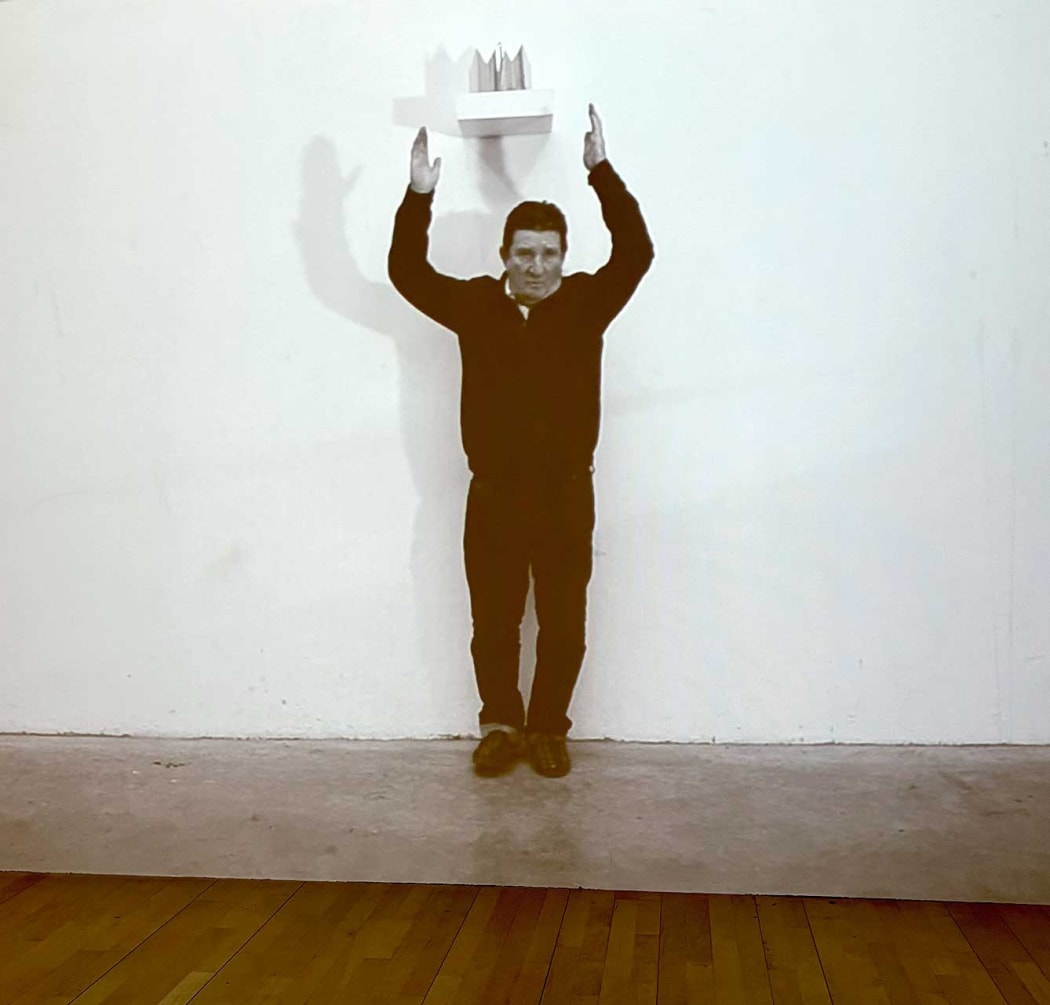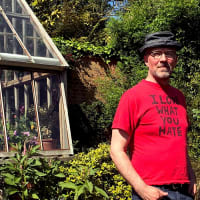
Still from I Want My Crown, 2023 video pojection
We saw several exhibitions while we were in Edinburgh, however, one stood out for us at the Scottish National Gallery of Modern Art, Modern One. I Want My Crown, amounts to a mini-retrospective by internationally acclaimed Scottish artist Bruce McLean. For those unfamiliar with Bruce's work, it is a well-selected capsule exhibition picking out highlights from his long career. It is the perfect opportunity to get to know this important artist's body of work. We were visiting the museum after the exhibition had been due to close on 1 October 2024, so we were fortunate it had been extended, and it has now been extended still further to close on 23 November later this year.
I Want My Crown, 2023, 30 second clip from video pojection
Since graduating from Glasgow School of Art in the early 60s Bruce Mclean has worked consistently, producing his own solo projects, as well as numerous collaborations over a sixty year period. The exhibition coincides with his 80th birthday. During this time he helped re-define the role of the artist, and what an artist can do in the later half of the twentieth century. He was among an influential group of young artists who came out of Saint Martin's School of Art (University of the Arts London), in the mid 60s who turned to performance, music and popular culture as they realised that fine art and particularly sculpture required new responses from artists across different media, including film and photography.

Photographic sequence documenting a Pose Work for Plinths, an early ‘live action sculpture’
Looking back, what unites Bruce’s work over the intervening six decades is a deadpan self-deprecating humour. He has used humour critically, to gently skewer the conventions of the art world that he was both a part of and yet as a Scot, also slightly separated from. His early solo performance and group work with the Nice Style Pose Band has been represented in photo documentary form in the exhibition. These events were centred upon Bruce and his collaborators, dressed in diner jackets, posing among a stage full of plinths, striking stances that mimicked those adopted by smart people in social situations - using the vigour and performance values of pop idols. These performances were intended to be funny. They coincided with the moment Monty Python broadcast their sketch of The Ministry of Funny Walks (1970), poking fun at the civil service. Bruce and his 'band' were making a similar commentary on the art 'establishment' and its ongoing relationship with the avant-guarde.
I first came across Bruce's work in one of the contemporary galleries I worked in during the 80s and 90s. At that stage he had worked across a broad selection of media – including photography, performance, painting, printmaking, film, and ceramics. Bruce stuck out among the stable of international artists the gallery represented. He was extremely versatile in his approach, working more like a designer or architect. Equally confident working in these media, he was producing a lot of drawings while working on built commissions for architectural projects. These were high-end developments providing bespoke components for interiors like a prestigious cocktail bar or café, or external features like a social space in a public square or a portico for an office block or restaurant.

Bruce McLean installation at Modern One
These purpose built, sculptural interventions employed his breezy, visual vocabulary developed in the distinctive, calligraphic paintings he made, there are only one or two in this exhibition, so take a look at his paintings in the Scottish National Collection, if you don't know his work. They are generous and lively with poured paint and drawn elements, drawn directly into the painted surface.
His architectural pieces were made by collaborating with top-flight fabricators using high quality finishes in steel and richly coloured terrazzo. These architectural installations had a performative, theatrical presence. The images he embedded within the materials lent a humane, elegance to what would otherwise have been chilly, hard-edged social spaces. This body of work although highly finished, continued to reveal Bruce’s fascination with human behaviour and the strange things people say or do.

Bruce McLean installation at Modern One
From the trivial to the outright silly, his visual language has exploited exaggerated gestures, conventions and inexplicable manners, and how we loose sense of ourselves, living an 'enviable life'. His work is strongest when encompassing the ‘theatre’ of social interaction, and the style and posturing of those who are intent on impressing people. So even his early work is strangely apposite to the present day, the era of Instagram and TikTok and the army of self-obsessed self-promoters who serve hourly helpings of what used to be private in real life, into their online lives.

Bruce McLean installation at Modern One
One of the more recent works, and a centre-piece to the show, is a film made with Suffolk-based artist and filmmaker Eileen Haring Woods. Its title 'I want my crown' is the title of the exhibition. It shows Bruce engaged in a solipsistic, shuffling dance, while gesturing toward the crown positioned on a shelf above head, just out of reach. The film was made during his exhibition at The Cut Halesworth, Suffolk in September 2023.
Visitors to the exhibition hear the soundtrack to the film echoing through the galleries as they approach the area where the exhibition is installed on one of the upper floors of the museum. It is gentle, witty and memorable. I Want My Crown neatly encapsulates McLean’s boundary-pushing work and confirms him as one of the most interesting and influential artists of his generation.
Bruce McLean has exhibited in many important exhibitions worldwide including When Attitudes become Form, Berne, New Spirit in Painting, RA London, Zeitgeist Berlin, and Documentas 6,7 and 8 and in the International Pavilion Venice Biennale. His work is in private and public collections all over the world, including Tate Gallery, Museum moderner Kunst, Vienna, The National Museum of Art, Osaka, The V&A London and Dundee, The Arnolfini Gallery, The National Gallery of Modern Art, Edinburgh, Arts Council and British Council collections.
Scottish National Gallery of Modern Art
Modern One, Edinburgh
About the author

Paul Barratt
Paul Barratt started working in contemporary art galleries in 1989, having graduated in Fine Art from Goldmsith’s, London University. He initially worked at Anthony d’Offay Gallery, one of the contemporary art dealers, who dominated the London art market in the 80s and 90s. He was approached by the Lisson Gallery to be gallery manager for the influential art dealer Nicholas Logsdail. This was followed by a short period in New York at Gladstone Gallery, to work for visionary art dealer Barbara Gladstone, working with the artist and filmmaker Matthew Barney.
On his return to London, Paul secured a place on the postgraduate curatorial course at the Royal College of Art, to complete an MA. After graduation in 2001, he worked as an independent curator on several projects in Oslo, London, Brighton and Basel, before joining Paul Vater at his design agency Sugarfree in 2004. He has worked with Paul ever since.





